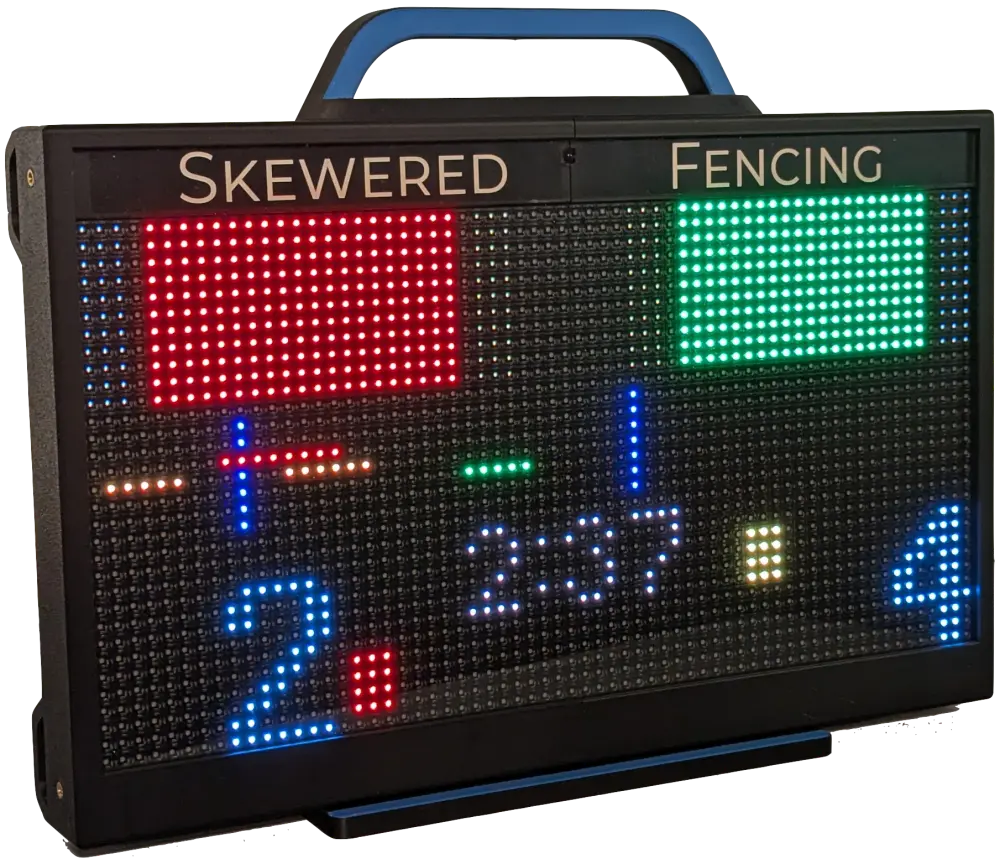
Questions? Email us at info@skewered-fencing.com.
Overview
The Skewered Fencing Scoring Box is a modern scoring box for the sport of fencing. Rather than using a set of fixed lights and indicators, it takes the approach of using a full LED display. This allows it to show much more detailed information than a traditional box and makes it the ideal box for clubs!
It starts with all of the basic features you expect from a scoring box:
- FIE-compliant timing for Foil, Epee, and Saber.
- A connection for grounded strips.
- A remote control.
- Bout timer, break timer, and passivity timer.
- Score and yellow/red card display, period indicators.
Then adds cutting-edge functionality:
- Display the late hit timing and whipover indicators.
- Full timeline of each hit, including blade contact from parries.
- Extensive connectivity (serial connections, Wi-Fi, or Bluetooth) for connecting with external repeater lights, Fencing Time, or video replay apps like SFS.
Along with these convenient features:
- Automatic sleep mode.
- Optimized light arrangement for each weapon.
- The remote control is rechargeable and configurable.
- Buzzer tone and volume can be customized on each box to distinguish from other nearby boxes.
- Colorblind-accessible graphical design.
- Each box can have a distinctive color highlight and matching remote.
- Flexible, configurable mounting options.
- A convenient storage container.
- A travel-sized version is also available!
Modern Display
Because the Skewered Fencing Scoring Box has an LED display instead of fixed indicator lights, it can optimize the lights for each weapon. For example, for Epee the colored touche lights are the most prominent along with only small yellow short lights. On the other hand, Saber has medium-sized short (yellow) and fault (white) lights with a large colored touche light.
Flexibility
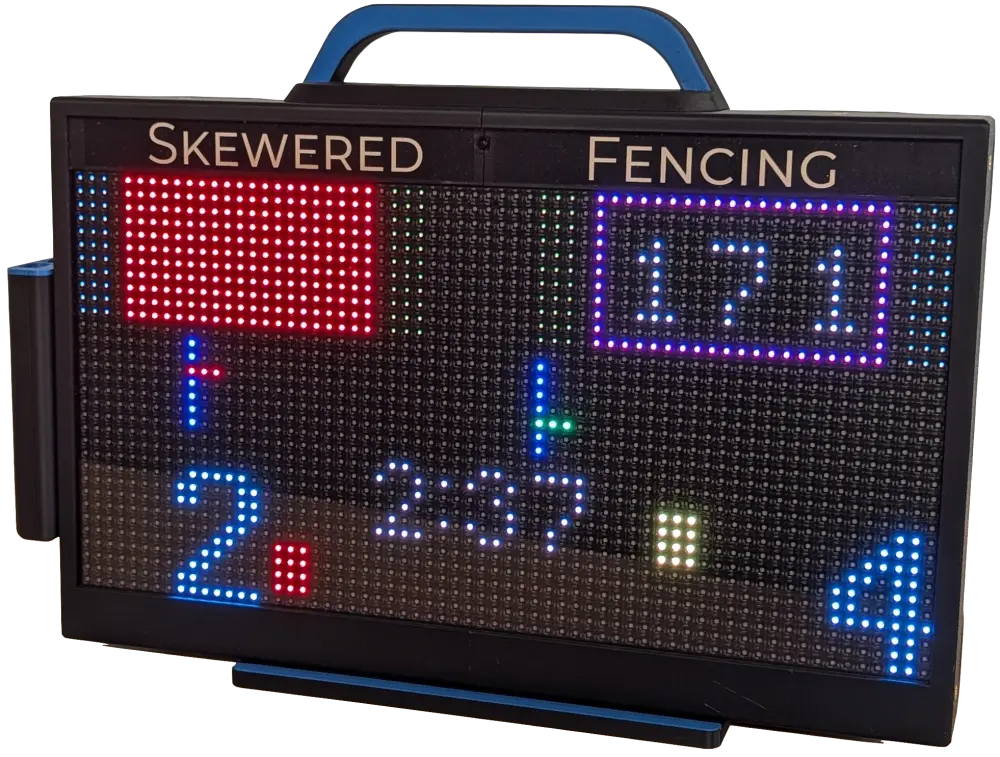 Using an LED display allows additional information to be displayed when
needed. For example, a late hit can be indicated along with exactly how
late the hit was. In this example image on the right, the green fencer was
1ms late for Saber's 170ms lock-out.
Using an LED display allows additional information to be displayed when
needed. For example, a late hit can be indicated along with exactly how
late the hit was. In this example image on the right, the green fencer was
1ms late for Saber's 170ms lock-out.
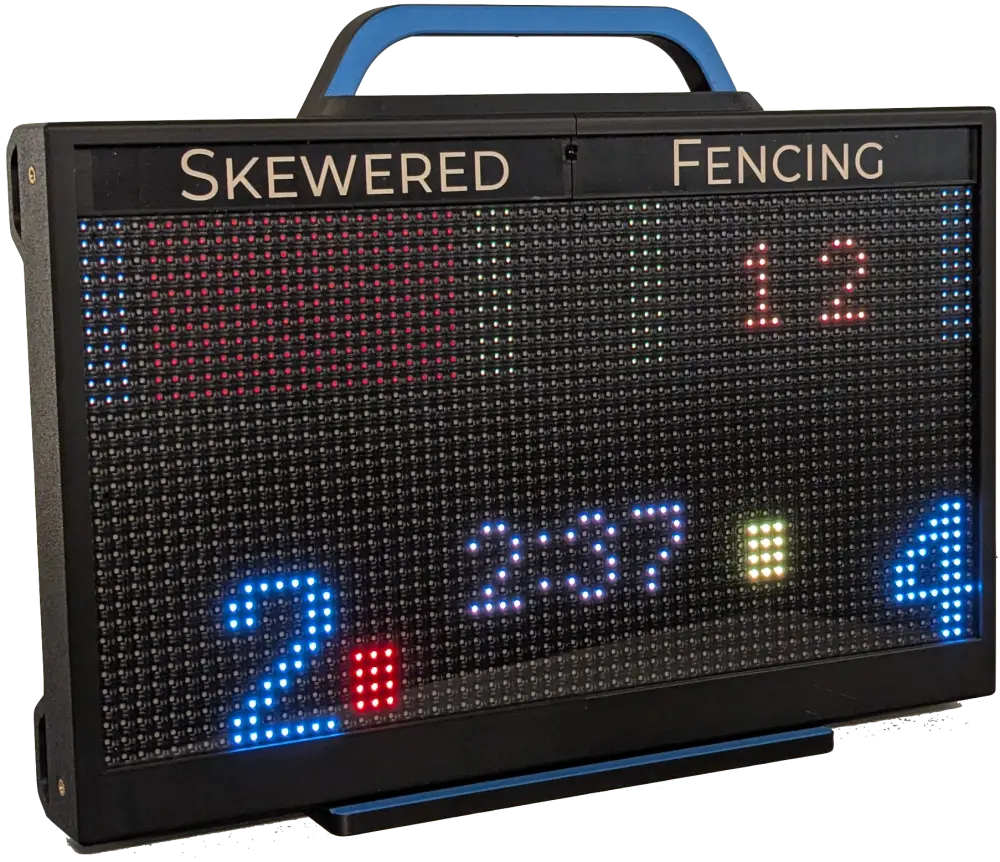
Here's another example: In Saber, if a very short hit occurs during a parry, the hit should be ignored. With most boxes this is confusing to the fencers because they may have felt the hit. The Skewered Fencing Box will instead show a whipover indicator.
The graphical layout has been carefully designed to make it accessible for color-blindness. For example, the yellow and red card indicators are in different positions.
Timeline
The Skewered Fencing Box has extremely precise timing, checking for hits between fencers 20,000 times per second. In addition, it can detect not only valid and invalid hits but also blade contact from parries.
The combination of precise timing and the flexible display allows a completely novel feature: The timeline display (patent pending). The last second of the indicator lamps continuously scrolls across. When a hit occurs, this scrolling history is frozen that everyone can see the sequence of events that occurred near the hit.
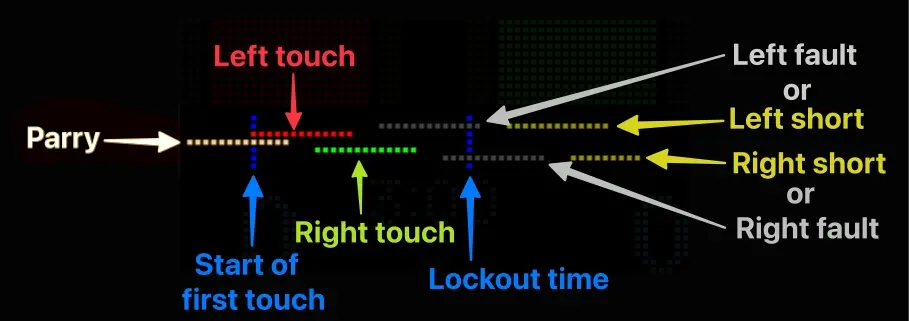
Timeline diagram
This provides a visual indication of the sequence of events around a hit.
The center orange line indicates blade contact (parries). Above and below
that are red or green lines indicating valid contacts by the corresponding
fencer. Finally, on the top and bottom it will show fault indicators (e.g.
broken or unplugged body cords causing a white light) or short indicators
(shorting to the bell guard in epee or shorting to a fencer's own lamé in
foil or saber) if applicable.
When a hit occurs, the timeline freezes and two vertical blue lines appear:
The first vertical blue line indicates the start of the first hit. The second vertical blue line indicates the end of the lock-out period for the current weapon (170ms for saber in this case).
Here's an example that you might see in a real bout:
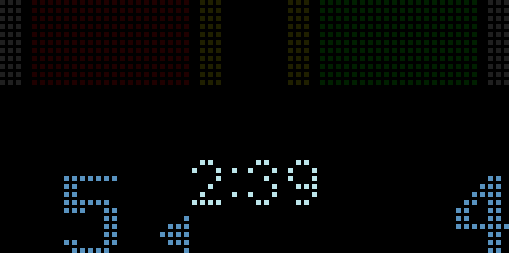
- Right before the initial touch, there were a few blade contacts between the two fencers (indicated by the orange pixels to the left of the first hit blue line).
- Then Green made a valid touch contact, initiating the lockout period
- Before Green came off of the lamé, there was again blade contact between the two fencers (indicated by the orange pixels during the lockout period).
- Finally, after a short delay but before the lockout, Red makes valid touch contact.
This sequence of interactions is consistent with a beat attack from the right and a late parry from the left.
This timeline can help disambiguate whether a parry was made before the hit or after. Or whether a flaky body cord connection was acting up during a hit! It's also really fun to watch, especially if you short to your own lamé while the other fencer is hooking up.
Here are some other timeline examples:
Saber
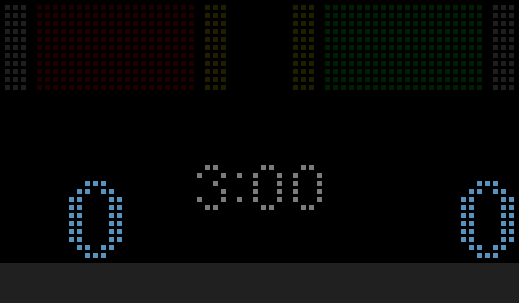
Epee
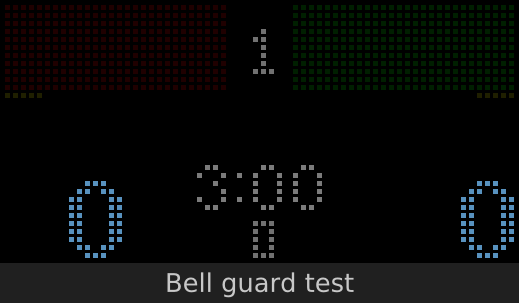
Foil
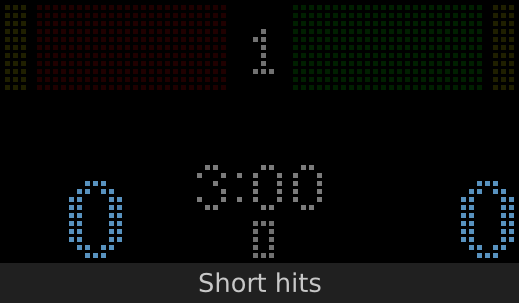
Configurability
The graphical display allows unparalleled configurability. For tournaments where some fencers may not be familiar with the timeline or additional timing indications, these can be disabled to make this scoring box act like a basic scoring box.
Connectivity
The Skewered Fencing Box is designed to integrate with many other applications:
Wi-Fi
The scoring machine includes Wi-Fi connectivity that will provide native
integration with Fencing Time.
Bluetooth
The machine also includes Bluetooth integration that will provide native
integration with the iOS-based video replay app
SFS (Super Fencing System).
Serial
The box includes an RJ-11 serial connection that can connect to other
Skewered Fencing products: A video replay system / repeater display and an
adapter to convert to the Favero RJ-11 protocol.
There will also be a future serial-to-ethernet uplink for hardwired Fencing Time integration.
Programmable, Rechargeable IR Remote
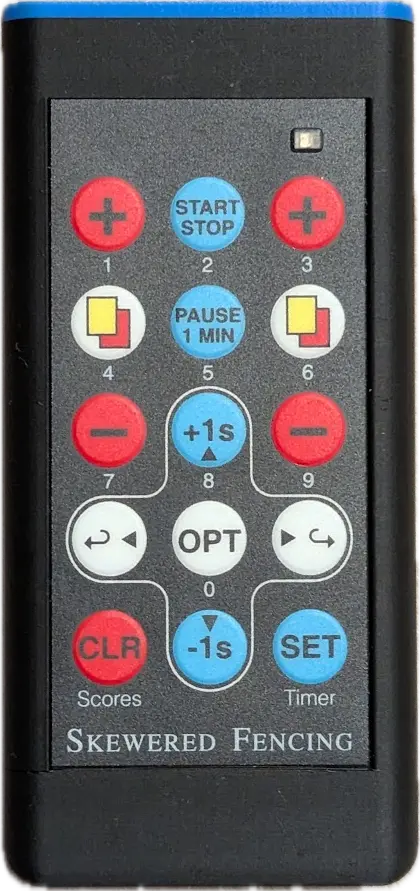
Each box comes with a custom IR remote with satisfying tactile buttons and
a helpful indicator light.
Each remote includes two high-intensity IR emitters (for both narrow and
wide-angle emission).
Each remote can be easily set to a specific IR channel and paired with a
corresponding fencing box so that multiple boxes can be used in the same
area.
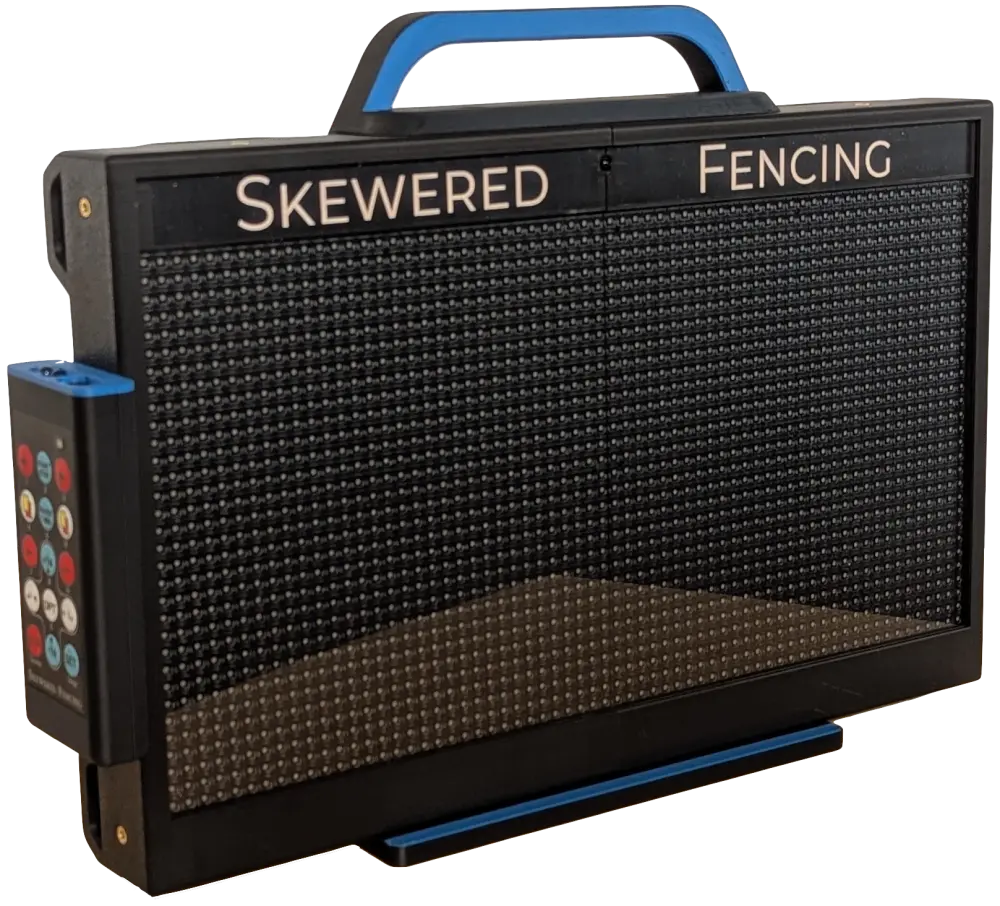
The remotes are trivially rechargeable with any standard USB-C charger.
Each remote has embedded magnets that attach to the scoring box... or any other metal surfaces!
Distinctive colors
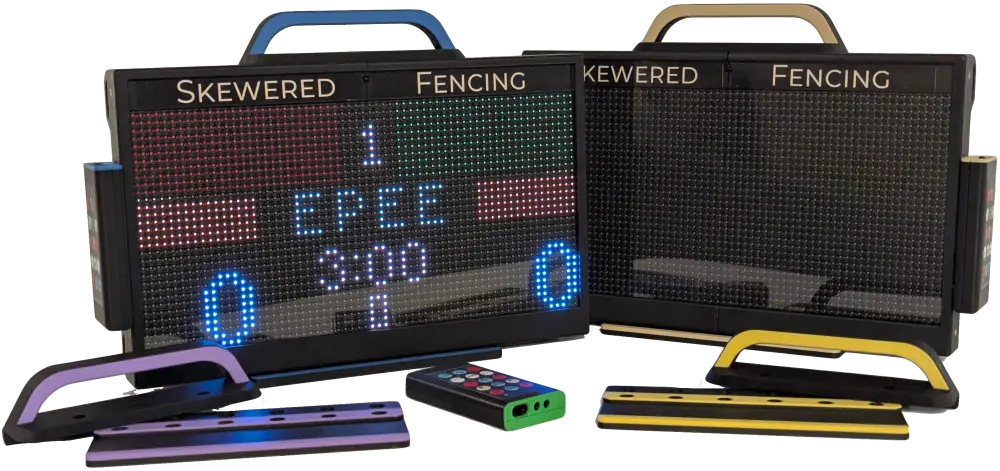
Each box is made to order with a variety of possible color highlights
available. Matching remote colors prevents confusing remotes between
boxes!
Of course, remotes can always be temporarily reconfigured to use with
another box if necessary.
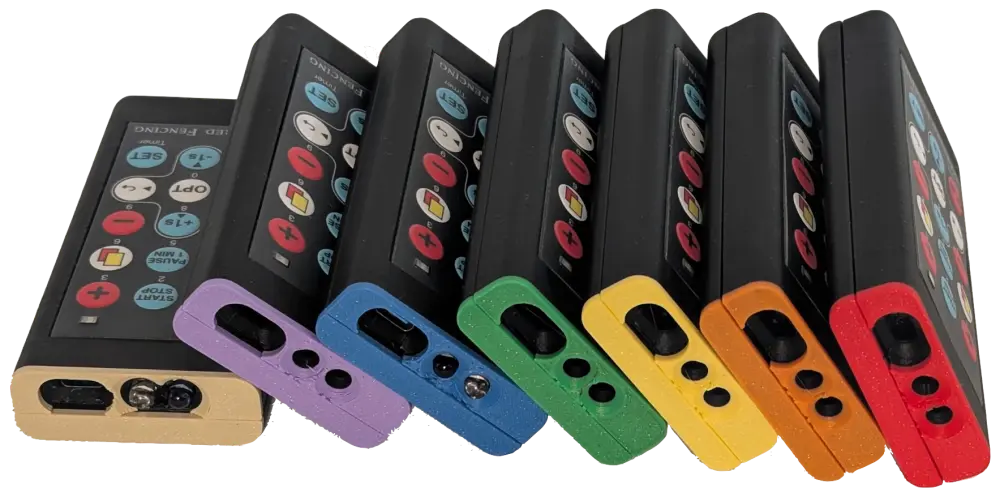
Flexible Mounting Options
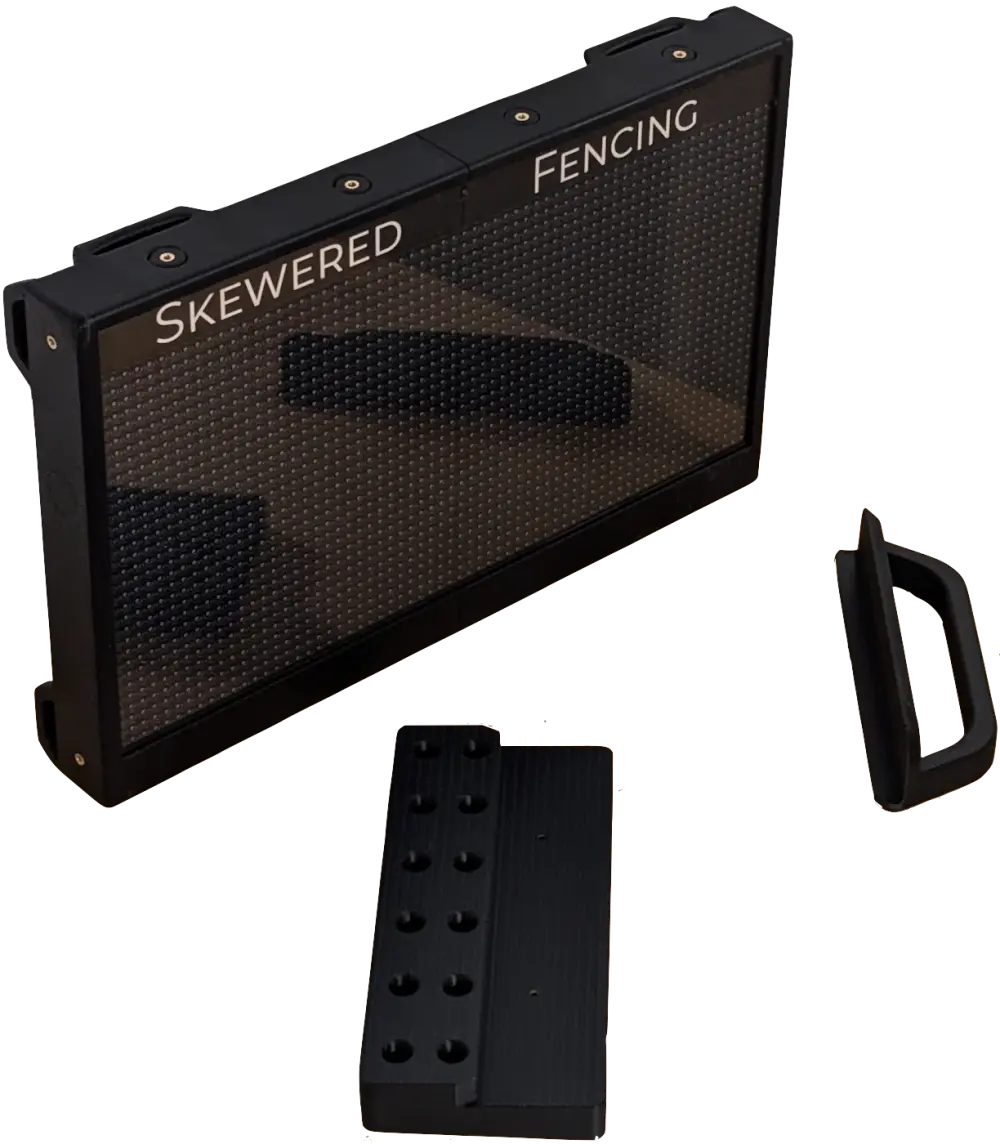 There is a standard handle and table-top stand that can be attached to the
box. The table-top stand is tilted slightly up for better visibility when
it's on a short table.
There is a standard handle and table-top stand that can be attached to the
box. The table-top stand is tilted slightly up for better visibility when
it's on a short table.
The boxes is also designed to be highly flexible in how it's mounted.
There are several M3 mounting screw holes around the outside of the
display that can be used for custom mounting.
This allows a wide variety of mounting options: Wall-mounted,
tripod-mounts, magnetic mounts, and more!
Auto sleep
For permanent installations, there's no need to turn the boxes on and off. After several minutes of inactivity, the display will turn off. As soon as any remote activity occurs or a fencer plugs in, the display instantly turns back on.
Travel-sized version
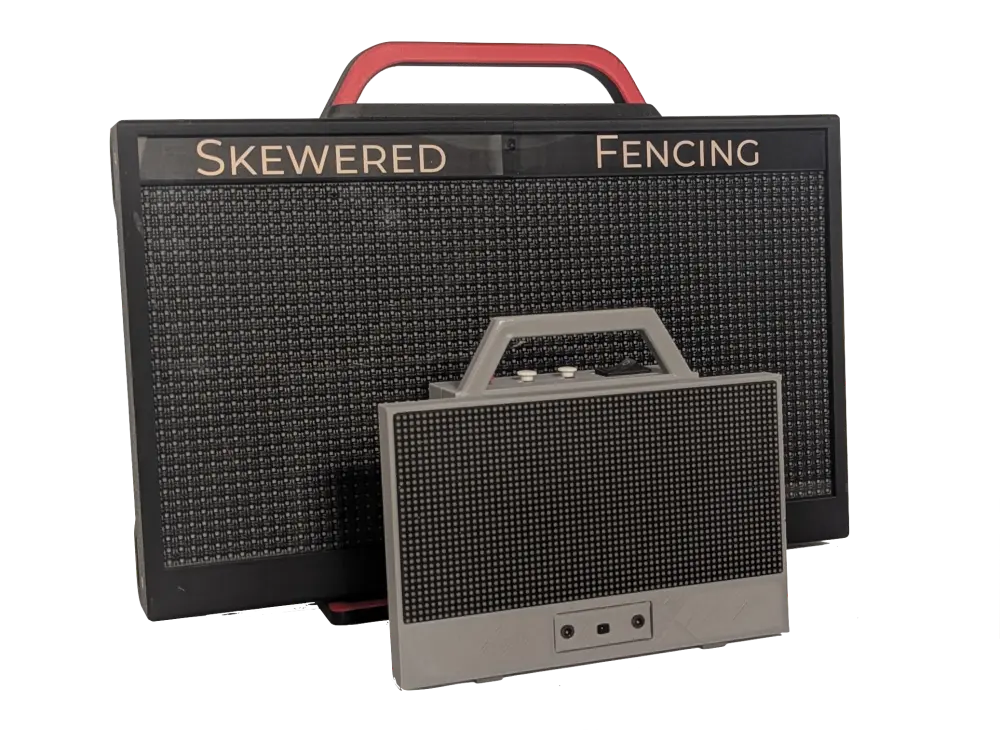 There is also a version that has a display that is half as wide and half
as tall, but is otherwise exactly the same: Same timeline, buzzer,
connectivity, remote, etc.
There is also a version that has a display that is half as wide and half
as tall, but is otherwise exactly the same: Same timeline, buzzer,
connectivity, remote, etc.
These are extremely portable!
Upgradeable
The boxes can be easily updated to the latest firmware by simply plugging a cable in the USB port and copying the new firmware over to the device when it shows up as a USB drive.
Feature Comparison
| Feature | Favero | Skewered Fencing | |||
|---|---|---|---|---|---|
| FA-01 | FA-05 | FA-15 | SKF-B1 | ||
| Basic | FIE-Compliant Timings | ✅ | ✅ | ✅ | ✅ |
| 3-Weapon support: foil, epee, and saber |
✅ | ✅ | ✅ | ✅ | |
| Remote | IR Remote | ❌ | ✅ | ✅ | ✅ |
| USB Rechargeable | ❌ | ❌ | ✅ | ✅ | |
| Display indicators | Clock | ❌ | ✅ | ✅ | ✅ |
| Score | ❌ | ✅ | ✅ | ✅ | |
| Last-scored | ❌ | ❌ | ❌ | ✅ | |
| Multiple points per touch warning | ❌ | ❌ | ❌ | ✅ | |
| Priority (random or manual) | ❌ | ✅ | ✅ | ✅ | |
| Penalty Card | ❌ | ✅ | ✅ | ✅ | |
| Passivity Card | ❌ | ❌ | ✅ | ✅ | |
| Passivity Clock | ❌ | ❌ | ❌ | ✅ | |
| Match / Period display | ❌ | ❌ | ✅ | ✅ | |
| Parry | ❌ | ❌ | ❌ | ✅ | |
| Whipover | ❌ | ❌ | ❌ | ✅ | |
| Late hit | ❌ | ❌ | ❌ | ✅ | |
| Connectivity | Serial connection | Low speed | Low speed | Low speed | High speed |
| Bluetooth connectivity | ❌ | ❌ | ✅ | ✅ | |
| Wi-fi connectivity | ❌ | ❌ | ❌ | Coming soon | |
| Advanced features | Reviewable Timeline | ❌ | ❌ | ❌ | ✅ |
| Seamless integration with Video Replay system | ❌ | ❌ | ❌ | ✅ | |
| Undo (in case of accidental score clears or time resets) | ❌ | ❌ | ⚠️ (score only) |
✅ | |
| Self-ref feature (Self scoring & Auto start signal) | ❌ | ❌ | ❌ | ✅ | |
| Can be powered via portable USB power bank | ❌ | ❌ | ✅ | ✅ [video] |
|
| Optimized per-weapon light layout | ❌ | ❌ | ❌ | ✅ | |
| Customizeable display layout | ❌ | ❌ | ❌ | ✅ | |
Timing Specifications
These scoring boxes are programmed to comply with the Oct 2024 FIE Material Rules. They feature ultra-precise timing, checking for hits 20,000 times per second and accurately evaluating connections on the strip with sub-millisecond precision.
| Weapon | FIE Requirement | Skewered Fencing | |
|---|---|---|---|
| Foil | Minimum contact time for valid hit | 14 ± 1ms | 14 ± 0.1ms |
| Double hit lockout time | 300 ± 25ms | 300 ± 0.1ms | |
| Epee | Minimum contact time for valid hit | 2 - 10ms | 2.1 ± 0.1ms |
| Double hit lockout time | 45 ± 5ms | 40.1 ± 0.1ms | |
| Saber | Minimum contact time for valid hit | 0.1 - 1.0ms | 0.2 - 0.3ms |
| Double hit lockout time | 170 ± 10ms | 170 ± 0.1ms | |
| Whipover exclusion time | 4-5ms to 15-20ms | 4.5ms to 15 ± 0.1ms | |
The Future
We're not done yet! There are more things we want to add, such as:
- Fencing Time integration with complete tournament support, including display of fencer names and bout identity.
- Update firmware over bluetooth or wifi.
- Auto-firmware update notifications. It will periodically check for firmware updates and notify you when an update is available.